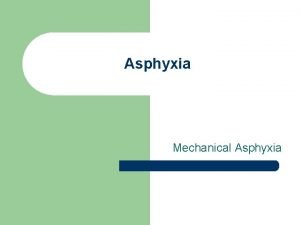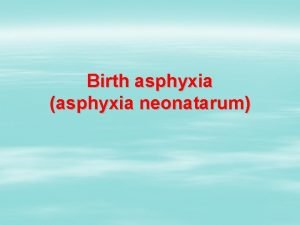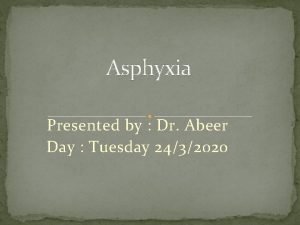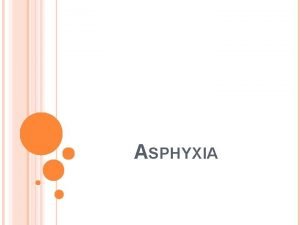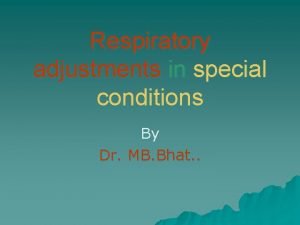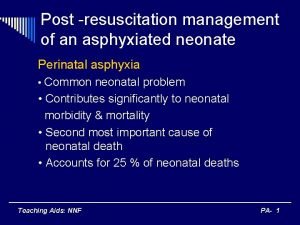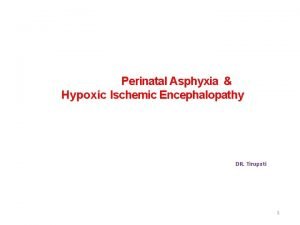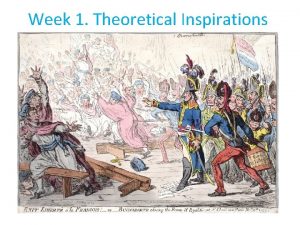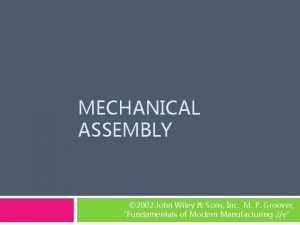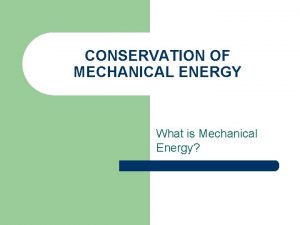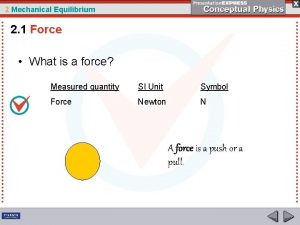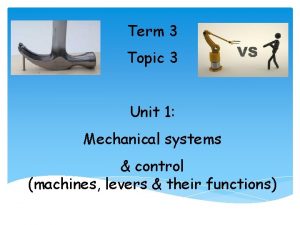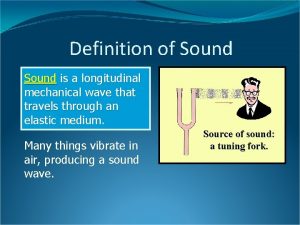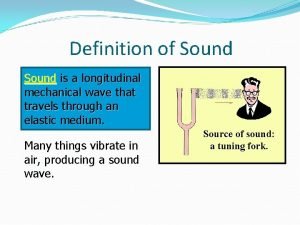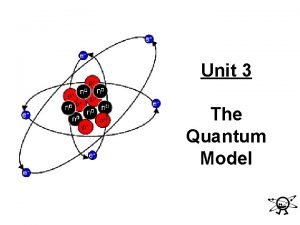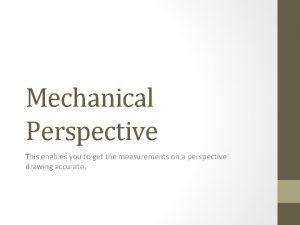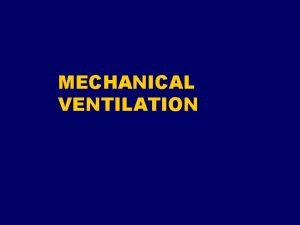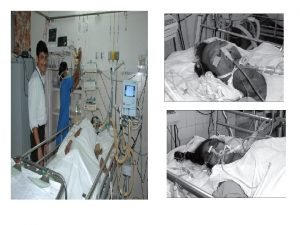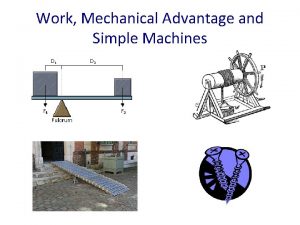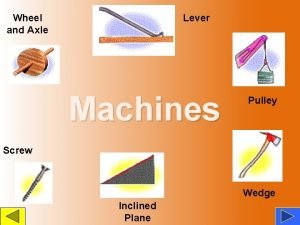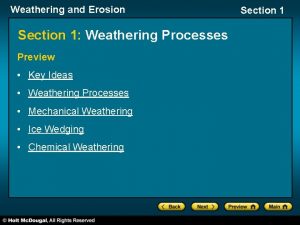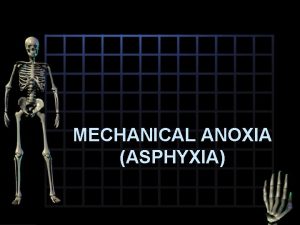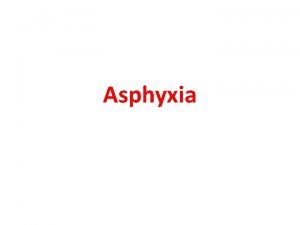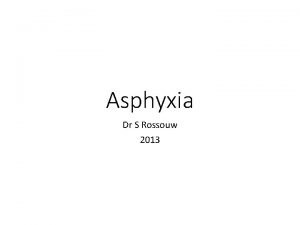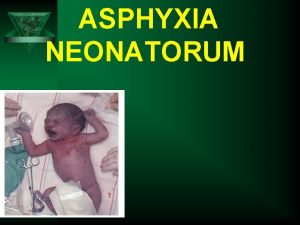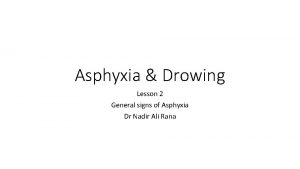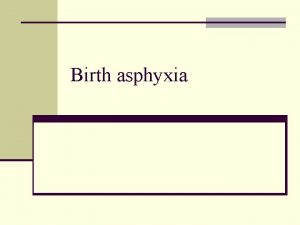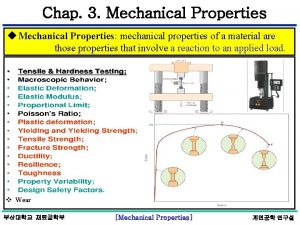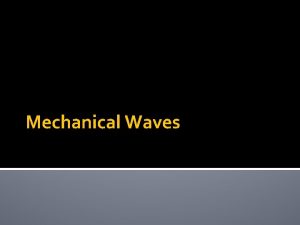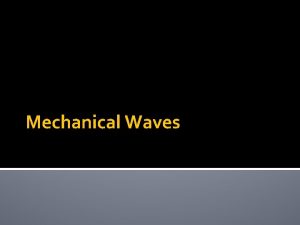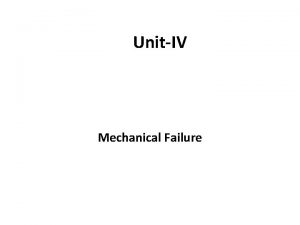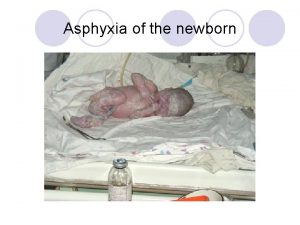Asphyxia Mechanical Asphyxia Definition l l l Equated





















































- Slides: 53

Asphyxia Mechanical Asphyxia

: Definition l l l Equated with lack of oxygen. The words means absence of pulsation. Anything that interferes with oxygen transfer can be called asphyxia (hypoxia or anoxia).

: Examples of Asphyxia l l l Absence or reduction of oxygen tension in the external atmosphere. Obstruction of the external respiratory orifices. Blockage of the internal respiratory passages. Restriction of the respiratory movements or paralysis from brainstem or cord damage or the use of curarelike drugs. Disease of the lungs that prevents or reduce gaseous interchange.

l l l Reduction in cardiac function leading to impairment of the circulation ( stagnant anoxia ). Reduced ability of the blood to transport oxygen (co). Inability of the peripheral tissue cells to utilize the oxygen delivered to them ( cyanide ).

: Mechanical Asphyxia Suffocation: death from deprivation of oxygen in the environment. l Smothering: blockage of the external air passages by a hand or a soft fabric. l Gagging: fabric or adhesive tape occludes the mouth while the nasal passages remain patent. l

Choking: blockage of the upper airways by some foreign body. l Manual strangulation: (throttling) applying neck pressure by the hand. l Ligature strangulation: applying external pressure to the neck by a ligature (garroting). l Mugging: applying neck pressure by an arm crooked around from the rear (arm-lock). l

: Classic signs of Asphyxia 1. 2. 3. 4. Petechial hemorrhages. Congestion and edema. Cyanosis. Engorgement of the right heart and fluidity of the blood.

: Petechial hemorrhages l l l Small pin-point collections of blood. Rupture of small venules. Caused by an acute rise in venous pressure leading to over distension and rupture of thinwalled peripheral venules. Hypoxia of the vein wall is an added factor. Found in lax tissues and in unsupported serous membranes.

: Petechial hemorrhages l l Found in the skin, sclera, conjunctivae, visceral pleura or pericardium. Also in the forehead, behind the ears and the circumoral skin. Vary in size up to 2 millimeter. If larger than this it is called ecchymoses. Tardieu spots: petechae found in the visceral pleura.

: Petechial hemorrhages l l l 1. 2. 3. 4. Venous engorgement may leads to frank bleeding from the nasal mucosa and the external auditory meatus. In the brain, petechiae occur in the white matter. Non spesific sign of asphyxia: Post mortem phenomenon Present in congestive deaths In abnormal posture Pigment foci

: Congestion and edema l l It is the result of obstructed venous return. It is most notable in the tongue, face, lips, pharynx and larynx above the level of venous obstruction. The color of congestion is dark pink. Congestion is associated with tissue swelling if the venous obstruction continues.

: Congestion and edema l l Edema is the result of transudation through capillary and venule walls. Hypoxia might be an added factor in edema. Froth may be profuse in cases of strangulation which emerge from the mouth and nostrils. Non specific sign of asphyxia.

: Cyanosis l l l Cyanosis depends on the absolute amount of reduced hemoglobin, at least 5 gm of reduced hemoglobin per 100 ml blood before cyanosis appears. Cyanosis follows congestion of the organs. Cyanosis may be overshadowed by hypostasis.

Engorgement of the right heart : and fluidity of the blood l l l Non specific sign of asphyxia. It is found in any type of congestive deaths. It is impossible to make a post mortem diagnosis of acute hypoxia by measuring the blood gases.

: Suffocation l l Reduction of oxygen concentration in the respired atmosphere. Found in decompression chambers, effect of partial vacuum and near explosive situation. Physical replacement of other gases or chemicals. (co, co 2, cyanide……) Children may asphyxiate by being trapped in a small air-tight space.

: Suffocation l l Rapid death is common before hypoxia can have had any physiological effect. Cause of death is over stimulation of the chemoreceptor system, leading to a parasympathetic (vasovagal) cardiac arrest. Classic signs of asphyxia are almost always absent. Autopsy findings are negative

: Smothering l l Mechanical occlusion of the mouth and nose. The smothering agent is a fabric or a hand. Manner of death: homicidal or accidental in cases of infants. Sudden infant death syndrome. (cot deaths)

: Smothering Autopsy findings: l Multiple oval or semi lunar bruises l Abrasions around the mouth and nostrils l Circumoral area of pallor l Examination of the mouth

Overlaying of infants: l l Infant found dead in the morning in the maternal bed. SIDS

: Plastic bag suffocation l l l Manner of death: suicide or homicide or accidental. It can be rapid and leave no signs of asphyxia. Mechanism of death: cardio-inhibitory rather than hypoxic.

: Gagging l l l Fabric or adhesive tape occludes the mouth while the nasal passages remain patent. Similar situation arises when a gag is thrust into the mouth. Obstruction is due from saliva and mucus or moving of the gag backwards into the nasopharynx.

Choking: l l l Blockage of the internal airways between the pharynx and the bifurcation of the trachea. Cause of death: pure hypoxia from occlusion of the airway (signs of asphyxia). Or: neurogenic cardiac arrest which may be accelerated by excess catecholamine release from the adrenaline response.

: Choking Causes: l Foreign bodies l Dentures and hemorrhage l Acute obstructive lesions l Food material l Inhalation of irritant fumes (chlorine in swimming pools)

: Traumatic asphyxia l l l Acts by restricting respiratory movements and thus prevents inspiration. Manner of death: accidental or homicidal (burking). Classic signs of asphyxia are marked.

Traumatic asphyxia l l l Autopsy findings: External: signs of asphyxia and line of demarcation Internal: signs of asphyxia and the lungs are usually dark and heavy

Traumatic asphyxia l Mechanism of asphyxia: pressure on the chest forces blood into the great veins and as the venous valves in the subclavian vessels prevent displacement into the arms, the extra volume is forced up the valveless jugular system to congest the head and neck.

: Postural asphyxia l l l When a person remains in a certain position for an extended time. In trapped persons, drunken The normal venous return to the heart may be impaired

Postural asphyxia l l Positions are inversion either of the whole body or the upper half Inversion may occur during torture: crucifixion has an element of postural asphyxia as inspiration would be impeded by the weight of abdominal viscera upon the diaphragm.

Fatal pressure on the neck

: Mechanism of death Airway occlusion l Occlusion of the neck veins l Compression of the carotid arteries l Nerve effects: (carotid sinus and sheath) - Afferent: glossopharyngeal nerve to the tenth nucleus in the brain stem. -Efferent: return via the vagus supply to the heart. (parasympathetic) -2 possible mechanisms on the heart. l

(MLA of cardiac arrest (vagal l l Sudden unexpected deaths Death occur rapidly without any signs of asphyxia Intent of the assailant Time passed from start of pressure to death

(MLA of cardiac arrest (vagal l 1. 2. 3. 4. 5. 6. 7. Other causes: Blows to the neck (commando punch) Blows to the larynx Impaction of food in the larynx Cold water in immersion Blows to the testicles Dilatation of the uterine cervix Blows in the epigastrium

Manual strangulation l Common method of homicide l Seen in domestic homicides, in sex related murders and in child killings.

Autopsy in manual strangulation Bruises: -discoid (from finger-pads) -1 to 2 cm in size -cluster at the sides of the neck -under the angles of the jaw -fresh (dark red or purple) -superficial raised heamatomas l

Autopsy in manual strangulation Abrasions: -from assailant or victim -fingernails abrasions -along the margin of the jaw line -straight or curved -fingernail scrapings should be taken (victim and assailant) l

Internal appearances in manual strangulation l l Bruises in the neck tissues X-ray to determine the state of the laryngeal cartilages Injury of the carotids Fracture of the thyroid or hyoid horns

Manual strangulation Possible Mechanisms of death: -obstruction of the airways -reflex cardiac arrest -cerebral ischemia l

Ligature strangulation (garrotting) Manner of death: -homicidal -suicidal -accidental l Possible mechanisms of death: -obstruction of the airways -reflex cardiac arrest -cerebral ischemia l

Ligature strangulation Ligature mark -deeply imbedded in the skin -edema of the tissues above the ligature -skin mark may be red -narrow zone of reddened hyperemia at either margin of the mark -position of the ligature (encircle the neck horizontally at a lower level) l

Ligature strangulation Abrasions on the neck l Fingernail marks l Internally: -superficial hemorrhage under the ligature mark -damage of neck structures -there may be laryngeal injury -injury of the carotids l

Hanging l l l Force applied to the neck Gravitational drag Weight of the body or part of the body

Hanging Manner of death: -suicidal -homicidal -accidental: l During play l At place of work l Sexual asphyxia l

Hanging Judicial hanging: -severe mechanical disruption of the neck structures -dislocation of the cervical spine -traction on the spinal cord -spinal cord or brainstem disruption (damage) -cerebral function ceased immediately and heart continued to beat up to 20 minutes until hypoxia caused death. l

Hanging Methods of hanging l Hanging marks: -suspension point -complete or incomplete circles (split knot or fixed knot) -impression of the knot -abrasions -narrow red zone around the ligature mark -situated high up on the neck l

Hanging l l l Post-mortem hypostasis Damage of neck structures Damage of the carotids

Mechanism of death in hanging l l l Reflex cardiac arrest Cerebral ischemia (3 -11 seconds) Congestive death Airway obstruction (base of the tongue or crushing of larynx) Spinal cord-brainstem disruption

drowning l Type of violent asphyxia l Submersion of air orifices under a fluid l Not all immersed body have died of drowning

drowning Bodies recovered from water: -natural diseases before falling into water natural diseases while already in water Injury before being thrown into water Injury while in water Effects of immersion other than drowning: 1. Sudden laryngo-spasm 2. Vagal inhibition -drowning (replacement of air by water soft or hard) *cause of death: mechanical hypoxic effect l

drowning Manner of death: -accidental -suicidal -homicidal l

drowning Immersion in fresh water: -water will be absorbed from the alveolar space -reach the left side of the heart and systemic circulation (hypervolaemia) -left sided heart failure -Hemodilution and hemolysis -hyperkalaemia (myocardial failure) l

drowning Immersion in hard water: -fluid will be drawn from the circulation into the lungs -acute pulmonary edema -right sided heart failure l

: Classic findings in drowning l l l l Cadaveric spasm (alive while in water) Froth Washerwoman skin Maceration (glove and stocking) Cutis anserina (goose-flesh) Hypostasis Adipocere (hydrolysis and hydrogenation of NSF to SF)

Internal signs in drowning l l Froth Lungs: pale, over-inflated, filling the thoracic cavity Stomach Diatoms (unicellular organisms covered with silica shell)
 Equated definition
Equated definition Equated installment
Equated installment Define chocking
Define chocking Actual mechanical advantage vs ideal mechanical advantage
Actual mechanical advantage vs ideal mechanical advantage Questions on asphyxia
Questions on asphyxia Perinatal asphyxia
Perinatal asphyxia Perinatal asphyxia
Perinatal asphyxia Silvery spots in asphyxia
Silvery spots in asphyxia Silvery spots in asphyxia
Silvery spots in asphyxia Asphyxia medical term
Asphyxia medical term Stages of asphyxia
Stages of asphyxia Management of asphyxia neonatorum after resuscitation
Management of asphyxia neonatorum after resuscitation Levene staging
Levene staging Hyponuria
Hyponuria Mechanical solidarity definition sociology
Mechanical solidarity definition sociology Mechanical solidarity definition sociology
Mechanical solidarity definition sociology Criticisms of conflict theory
Criticisms of conflict theory Sublevel d
Sublevel d What is the electron configuration of 24cr4+?
What is the electron configuration of 24cr4+? Mechanical work example
Mechanical work example Mechanical assembly methods
Mechanical assembly methods Hybrid
Hybrid Define mechanical efficiency
Define mechanical efficiency Sacred and profane meaning
Sacred and profane meaning Mechanical energy examples
Mechanical energy examples Mechanical equilibrium definition
Mechanical equilibrium definition Mechanical equilibrium definition physics
Mechanical equilibrium definition physics Linked first class lever
Linked first class lever Quantum numbers definition
Quantum numbers definition Motion transformation systems
Motion transformation systems Law of mechanical energy
Law of mechanical energy Define mechanical wave
Define mechanical wave Mechanical wave definition
Mechanical wave definition Wietrzenie
Wietrzenie Quantum mechanical model definition
Quantum mechanical model definition One point perspective from plan and elevation
One point perspective from plan and elevation Ideal mechanical advantage definition
Ideal mechanical advantage definition Actual mechanical advantage definition
Actual mechanical advantage definition Positive end expiratory pressure
Positive end expiratory pressure Define ventilation
Define ventilation Ytu erasmus
Ytu erasmus Examples of cutting tools in workshop
Examples of cutting tools in workshop When is mechanical energy conserved
When is mechanical energy conserved Mechanical machine
Mechanical machine How do you calculate mechanical advantage
How do you calculate mechanical advantage Section 1 work and machines answer key
Section 1 work and machines answer key Examples of compound machines
Examples of compound machines What is mechanical energy
What is mechanical energy Speciation can only be observed over millions of years
Speciation can only be observed over millions of years Rit mechanical engineering
Rit mechanical engineering Physical weathering and chemical weathering venn diagram
Physical weathering and chemical weathering venn diagram Mechanical and chemical weathering venn diagram
Mechanical and chemical weathering venn diagram Mechanical and chemical weathering venn diagram
Mechanical and chemical weathering venn diagram Identify three agents of mechanical weathering
Identify three agents of mechanical weathering
